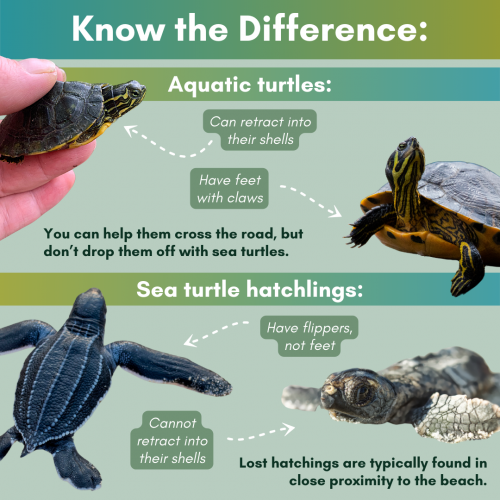This post includes a transcript of a video on @ufearthsystems Instagram. To view the video post, click here!
A Hatchling’s Journey
Voiceover: Sea turtle hatchlings in the wild are a rare and adorable sight, and it’s estimated that only 1 out of every thousand hatchlings make it to adulthood. This is due to natural processes like predation—as well as human-caused threats like light pollution and plastic litter.
Voiceover: As endangered species, sea turtles are protected by law and should not be touched or interfered with. But what should beachgoers do if they see a turtle hatchling that might be in distress? I spoke to an expert to find out.
David: My name is David Anderson. I’m the Sea Turtle Conservation Coordinator at Gumbo Limbo Nature Center for the city of Boca Raton.
David: Sea turtles do have a limited energy reserve in them to make that long swim offshore. When the hatchlings are in the sand incubating, and they hatch out of their shells, they come out onto the sand surface and crawl towards the ocean. And it’s imperative that they make that crawl and that swim as fast as they can. They have the remnants of their yolk sac in their bellies, and they’re using that as energy to make that long swim, several miles offshore, until they reach the Sargassum seaweed.
What Should I Do If I Encounter A Sea Turtle Hatchling?
David: If anyone on the beach encounters hatchlings, what they do depends on whether they see the hatchlings during the day or during the night. Of course, if they see hatchlings at night, and the hatchlings are crawling to the ocean, please do not touch. Let them do their thing that they’ve instinctively been doing for millions of years. Same thing during the day, sort of, hatchlings are of course crawling towards the water—let them be and allow them, once again, to do what’s natural.
David: There are some instances where a person may interact with and pick up a hatchling if that hatchling is certainly in danger.
Voiceover: Scenarios where a beachgoer might take action include:
- Finding a disoriented sea turtle hatchling far from the water in dunes, parking lots, or streets during the day. Hatchlings may lose their way in the night due to light pollution and wander off in the wrong direction. These disoriented hatchlings can overheat and run out of energy in the hot sun.
- Finding an injured hatchling, which may be a result of attempted predation from foxes, raccoons, or birds.
- If you’re not sure if you found a sea turtle in trouble, text or call the FWC hotline at 1-888-404-3922 or text Tip@MyFWC.com. They can advise your next steps.
Voiceover: Most importantly, do not put disoriented or injured hatchlings in the ocean. They are likely exhausted. Instead, take the hatchling to an FWC-approved hatchling drop off box and transport it on wet sand—not in water.
David: On our front porch we have a Florida Fish and Wildlife approved drop off box that we’ve had for well over 20 years. People can put those hatchlings in the drop off box. We check that box frequently throughout the day, seven days a week, and any hatchlings that are in there we will release the very same night.
Sea Turtle Conservation Assistant Rebecca Germany, who gave me a tour around Gumbo Limbo and introduced me to their current resident turtles Morgan and Lady McNubbins, is one of the team members who checks the box every day.
When she checked it, there were no turtles inside—just a surface of soft sand for any hatchlings that get dropped off. She stressed that these boxes are only for sea turtles. To tell the difference between sea turtles and other aquatic turtles found in Florida, refer to these key differences:

Sea Turtle Walks
Voiceover: If you want to learn more about sea turtles from experts like David, you can attend conservationist-led nesting watches or hatchling releases.
David: You could list pros and cons of programs which involve people coming out to interact with any endangered species, for that matter. But these programs really, really raise awareness. At the Wednesday night turtle walk that I just worked a couple of nights ago, there were a lot of children there, probably late elementary school, early middle school children, and they were lined up behind the turtle watching her nest. I’m sure, and I hope, that they were all inspired to maybe pursue the sciences and do something about sea turtle conservation in the future. Meanwhile, their parents may be donating to our cause or signing the kids up for sea turtle camp, or something else to inspire them. I think seeing our presentation and seeing the hatchlings or the nesting female firsthand is certainly inspirational to the ticket-paying public, and once again, I think inspiring them to move forward and helping us conserve these animals.
You can use this FWC page to find public sea turtle walks and hatchling releases in your nearest coastal area. If late-night turtle walks don’t fit your schedule, you can visit any of these state-permitted sea turtle rehabilitation centers to view these endangered species during open hours.
Special thanks to David Anderson and Rebecca Germany at Gumbo Limbo Nature Center for sea turtle conservation information!